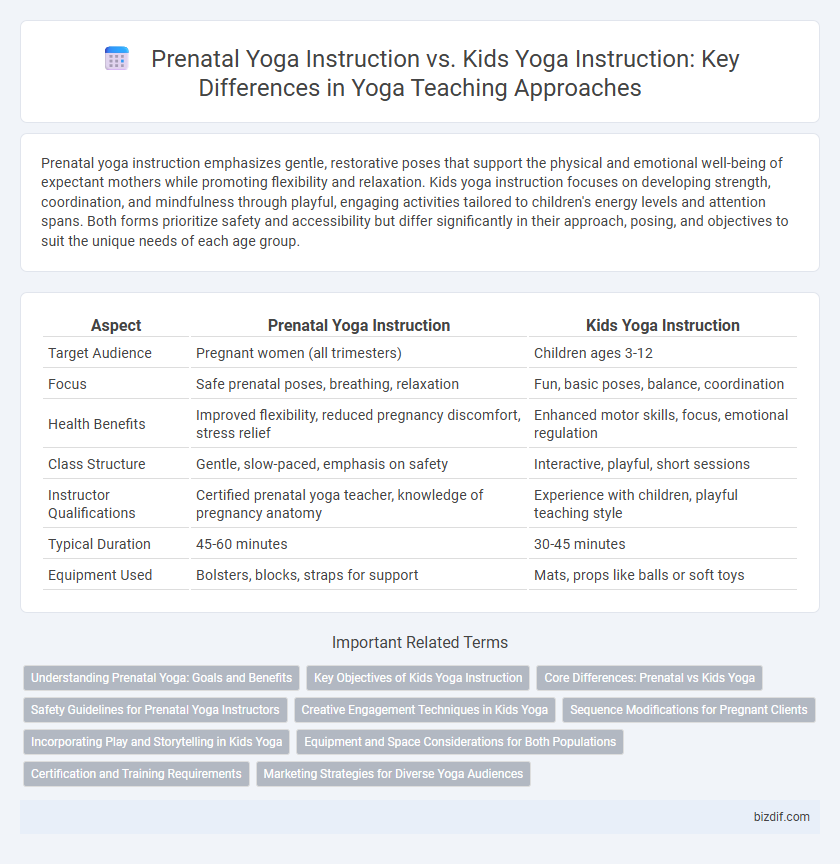Prenatal yoga instruction emphasizes gentle, restorative poses that support the physical and emotional well-being of expectant mothers while promoting flexibility and relaxation. Kids yoga instruction focuses on developing strength, coordination, and mindfulness through playful, engaging activities tailored to children's energy levels and attention spans. Both forms prioritize safety and accessibility but differ significantly in their approach, posing, and objectives to suit the unique needs of each age group.
Table of Comparison
| Aspect | Prenatal Yoga Instruction | Kids Yoga Instruction |
|---|---|---|
| Target Audience | Pregnant women (all trimesters) | Children ages 3-12 |
| Focus | Safe prenatal poses, breathing, relaxation | Fun, basic poses, balance, coordination |
| Health Benefits | Improved flexibility, reduced pregnancy discomfort, stress relief | Enhanced motor skills, focus, emotional regulation |
| Class Structure | Gentle, slow-paced, emphasis on safety | Interactive, playful, short sessions |
| Instructor Qualifications | Certified prenatal yoga teacher, knowledge of pregnancy anatomy | Experience with children, playful teaching style |
| Typical Duration | 45-60 minutes | 30-45 minutes |
| Equipment Used | Bolsters, blocks, straps for support | Mats, props like balls or soft toys |
Understanding Prenatal Yoga: Goals and Benefits
Prenatal yoga focuses on improving flexibility, strength, and relaxation specifically tailored for pregnant women's changing bodies, promoting healthy fetal development and reducing pregnancy-related discomforts such as back pain and stress. It emphasizes breathing techniques, gentle stretches, and mindful movement to prepare expectant mothers for childbirth. In contrast to kids yoga, prenatal sessions prioritize safety and pregnancy-specific modifications to support maternal and fetal well-being throughout each trimester.
Key Objectives of Kids Yoga Instruction
Kids yoga instruction focuses on enhancing physical coordination, emotional regulation, and social skills through playful and age-appropriate poses and breathing exercises. Key objectives include fostering mindfulness, improving concentration, and encouraging self-expression in a supportive group environment. Emphasis is placed on building confidence, promoting healthy habits, and nurturing creativity to support overall child development.
Core Differences: Prenatal vs Kids Yoga
Prenatal yoga instruction emphasizes gentle, restorative poses tailored to accommodate the physical changes and safety needs of pregnant individuals, focusing on breath control, pelvic floor strengthening, and relaxation techniques to support pregnancy and childbirth. Kids yoga instruction, on the other hand, prioritizes playful, imaginative movements that enhance motor skills, balance, and concentration while fostering emotional expression and social interaction. The core difference lies in prenatal yoga's focus on prenatal health and preparing for labor, versus kids yoga's aim to develop physical coordination, emotional resilience, and cognitive growth in children.
Safety Guidelines for Prenatal Yoga Instructors
Prenatal yoga instructors must prioritize safety guidelines by avoiding poses that compress the abdomen, emphasizing gentle stretching, and encouraging controlled breathing to support fetal health. Monitoring clients for signs of discomfort or dizziness and advising modifications to accommodate changing body dynamics is essential. Ensuring a calm environment with access to props for stability reduces injury risks and fosters a supportive practice for expectant mothers.
Creative Engagement Techniques in Kids Yoga
Creative engagement techniques in kids yoga instruction incorporate playful themes, storytelling, and interactive games to maintain children's attention and foster imagination. Unlike prenatal yoga, which emphasizes gentle, safe movements tailored to expectant mothers' physical needs, kids yoga focuses on dynamic, expressive activities that enhance motor skills and emotional development. Utilizing props, music, and group participation, instructors create an engaging environment that supports both physical fitness and cognitive growth in children.
Sequence Modifications for Pregnant Clients
Prenatal yoga instruction requires specialized sequence modifications to ensure safety and comfort for pregnant clients, including avoiding deep twists, intense abdominal work, and poses that compress the belly. In contrast, kids yoga instruction emphasizes playful, dynamic sequences tailored to children's developmental stages and shorter attention spans without the same physical contraindications. Understanding these differences allows instructors to create effective, age- and condition-appropriate yoga classes that promote health and well-being.
Incorporating Play and Storytelling in Kids Yoga
In kids yoga instruction, incorporating play and storytelling enhances engagement and supports cognitive development by making poses relatable and fun. Unlike prenatal yoga, which emphasizes gentle, restorative movements tailored for pregnancy, kids yoga uses imaginative narratives and interactive games to foster creativity and encourage physical activity. This approach not only improves flexibility and balance but also nurtures social skills and emotional expression in children.
Equipment and Space Considerations for Both Populations
Prenatal yoga instruction requires supportive props such as bolsters, blocks, and straps to ensure comfort and safety for expectant mothers, while spacious, quiet rooms with gentle lighting promote relaxation. Kids yoga instruction emphasizes vibrant, durable mats and playful props like colorful blocks or animal-themed cushions, necessitating an open, clutter-free area to encourage movement and creativity. Both populations benefit from non-slip surfaces and ample ventilation, but prenatal classes prioritize gentle cushioning and ergonomic seating, whereas kids classes focus on stimulating environments with age-appropriate equipment.
Certification and Training Requirements
Prenatal yoga instructors require specialized certification emphasizing anatomy, safety, and modifications for pregnancy stages to ensure maternal and fetal well-being. Kids yoga instructors must complete training focused on child development, creative teaching methods, and maintaining engagement through age-appropriate poses and activities. Both certifications prioritize safety but differ significantly in curriculum to address the unique needs of pregnant women versus children.
Marketing Strategies for Diverse Yoga Audiences
Tailoring marketing strategies for prenatal yoga involves emphasizing safety, relaxation, and prenatal health benefits, targeting expectant mothers through maternity centers and healthcare providers. Kids yoga marketing centers on fun, interactive, and developmental benefits, engaging parents via schools, community centers, and family-oriented platforms. Leveraging social media campaigns with age-specific content and testimonials enhances outreach to both diverse audiences, ensuring messaging resonates with their unique needs and interests.
Prenatal Yoga Instruction vs Kids Yoga Instruction Infographic

 bizdif.com
bizdif.com